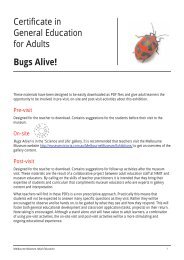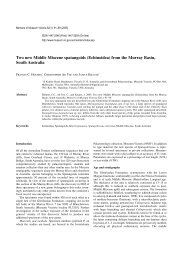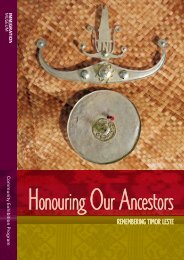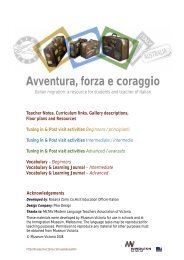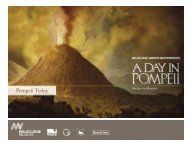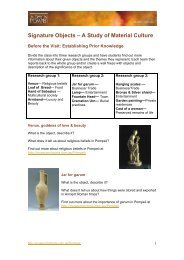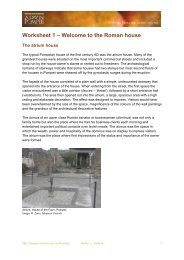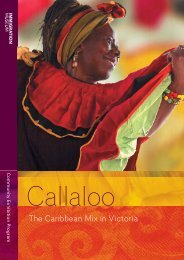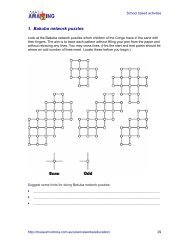[PDF] Andiamo a Pompei- Teacher Notes ... la - Museum Victoria
[PDF] Andiamo a Pompei- Teacher Notes ... la - Museum Victoria
[PDF] Andiamo a Pompei- Teacher Notes ... la - Museum Victoria
Create successful ePaper yourself
Turn your PDF publications into a flip-book with our unique Google optimized e-Paper software.
<strong>Andiamo</strong> a <strong>Pompei</strong>!<br />
Italian Education kit<br />
These education materials were developed for teachers and students of Italian visiting<br />
the Melbourne Winter Masterpiece exhibition, A Day in <strong>Pompei</strong>i which was held at<br />
Melbourne <strong>Museum</strong> in 2009.<br />
Acknowledgements<br />
Melbourne Winter Masterpieces is a <strong>Victoria</strong>n Government initiative and is exclusive to<br />
Melbourne, Australia.<br />
Presented in association with the Soprintendenza Speciale per i Beni Archeologici di<br />
Napoli e <strong>Pompei</strong>.<br />
The LOTE Italian education kit was developed by Rosaria Zarro, Co.As.It. Education<br />
Officer, <strong>Museum</strong> <strong>Victoria</strong> with Liz Suda, Program Coordinator-Humanities, Melbourne<br />
<strong>Museum</strong>.<br />
Many activities re<strong>la</strong>te directly to the story told in the exhibition so some activities may<br />
need to be adapted for use in the c<strong>la</strong>ssroom.<br />
The activities may be reproduced for teaching purposes. Permission to reproduce any<br />
material for other purposes must be obtained from <strong>Museum</strong> <strong>Victoria</strong>.<br />
© <strong>Museum</strong> <strong>Victoria</strong> 2009
<strong>Teacher</strong> <strong>Notes</strong><br />
The exhibition A Day in <strong>Pompei</strong>i, takes us back in time to experience life and death in<br />
this cosmopolitan Roman city. For teachers and students of Italian, the exhibition<br />
provided the rare opportunity to view extraordinary artefacts in an exhibition which<br />
explores the experience of that day in <strong>Pompei</strong>i, in August 79 AD.<br />
The online education kit <strong>Andiamo</strong> a <strong>Pompei</strong>! is a resource for teachers of Italian and<br />
includes the following—<br />
• Materials that unpack the key themes in the exhibition - food and dining, religious<br />
practices, recreation and entertainment, social structure, business and trade,<br />
luxury and beauty, baths, architecture, technology, volcanic activity and much<br />
more.<br />
• Tuning in activities with student worksheets and ICT research projects.<br />
• Pre/ Post activities for beginner and intermediate levels of Italian accompanied<br />
by a slideshow presentation of signature objects with questions in Italian.<br />
• The objects in the exhibition focus on the question, ‘What can we learn about<br />
daily life in ancient <strong>Pompei</strong>i by studying the material culture of its people?’<br />
Background information for teachers and students on the themes and gallery images of<br />
objects and multimedia elements can be found at the A Day in <strong>Pompei</strong>i portal at<br />
http://museum.victoria.vic.gov.au/<strong>Pompei</strong>i<br />
Establishing Prior Knowledge<br />
For students’ orientation and assessment of prior knowledge, teachers should select<br />
some of the Tuning In activities provided. In particu<strong>la</strong>r students need to understand three<br />
key concepts before they visit the exhibition.<br />
1. Time period and location of <strong>Pompei</strong>i<br />
What does <strong>Pompei</strong>i look like then and now?<br />
See <strong>Pompei</strong>i Today slideshow (<strong>PDF</strong>) for a visitors view<br />
2. The study of material culture as a way of understanding the past<br />
Signature Objects- <strong>Notes</strong> for teacher (<strong>PDF</strong>)<br />
See Signature objects slideshow (<strong>PDF</strong>) for images of key exhibition objects<br />
Web Quest – Archaeology<br />
3. The nature of volcanoes<br />
Web Quest – Could it happen again?<br />
http://museumvictoria.com.au/<strong>Pompei</strong>i<br />
2
Extension activities<br />
Follow-up and reflective sessions with students are essential. <strong>Teacher</strong>s could consider<br />
the Signature objects, slideshow and post-visit questions.<br />
Post-visit lessons could also include some of the following taxonomic activities:<br />
Using Anderson’s revised Bloom’s taxonomy approach, have the students move through<br />
a range of activities such as:<br />
Remembering<br />
Make a time line of the events leading to the destruction of Ancient <strong>Pompei</strong>i.<br />
Create and recite a poem based on the main theme of Ancient <strong>Pompei</strong>i.<br />
Understanding<br />
Make a cartoon strip showing the sequence of events on 24 August 79AD.<br />
Write and perform a p<strong>la</strong>y based on the day of the eruption in <strong>Pompei</strong>i<br />
Write a summary report on the day of the eruption.<br />
Prepare a flow chart to illustrate the sequence of events.<br />
Applying<br />
Make a scrapbook about Ancient <strong>Pompei</strong>i<br />
Write some text and compose some probing questions about the topic of Vesuvius<br />
for others.<br />
Present your findings in a data show for others, and raise questions for discussion.<br />
Analysing<br />
Construct a graph to illustrate selected information.<br />
Make a family tree showing re<strong>la</strong>tionships.<br />
Write a biography of an important person, such as Pliny the Elder, based on your<br />
research.<br />
Prepare a report about Vesuvius and the likelihood of another eruption.<br />
Research the role of g<strong>la</strong>diators in public entertainment in <strong>Pompei</strong>i.<br />
Evaluating<br />
Write a letter to the Soprintendenza Speciale per i Beni Archeologici di Napoli e<br />
<strong>Pompei</strong> outlining your concerns for the preservation of <strong>Pompei</strong>i.<br />
Prepare a case to present your view about …<br />
Creating<br />
P<strong>la</strong>n a marketing campaign for an exhibition about Ancient <strong>Pompei</strong>i.<br />
Design a book or magazine cover about <strong>Pompei</strong>i.<br />
Devise a campaign to raise awareness about the preservation of <strong>Pompei</strong>i.<br />
Create an advertising campaign for the museum to promote the study of <strong>Pompei</strong>i.<br />
http://museumvictoria.com.au/<strong>Pompei</strong>i<br />
3
Il vocabo<strong>la</strong>rio<br />
le stanze del<strong>la</strong> casa (rooms of the house)<br />
Atrium (in <strong>la</strong>tino) ―― l’atrio (in italiano) ―― entrance<br />
Triclinium (in <strong>la</strong>tino) ―― <strong>la</strong> sa<strong>la</strong> da pranzo (in italiano) ―― dining room<br />
Cubiculum (in <strong>la</strong>tino) ―― <strong>la</strong> camera da letto (in italiano) ―― bedroom<br />
Tablinum (in <strong>la</strong>tino) ―― il soggiorno (in italiano) ―― lounge room<br />
Peristilium (in <strong>la</strong>tino) ―― il cortile (in italiano) ―― internal garden<br />
gli oggetti del<strong>la</strong> casa (household objects) le decorazioni (decorations)<br />
<strong>la</strong> pento<strong>la</strong>- pot l’affresco- fresco<br />
<strong>la</strong> padel<strong>la</strong>- fry pan <strong>la</strong> statuetta- small statue<br />
il piatto - p<strong>la</strong>te <strong>la</strong> statua- statue<br />
<strong>la</strong> scodel<strong>la</strong>- cup<br />
<strong>la</strong> coppa per bere- drinking cup<br />
<strong>la</strong> brocca- jug<br />
il coltello- knife<br />
il cucchiaio- spoon<br />
<strong>la</strong> cisterna- water container<br />
<strong>la</strong> macina- grinder<br />
il mortaio- mortar<br />
il fornello- oven<br />
<strong>la</strong> casseruo<strong>la</strong>- casserole<br />
il vassoio- tray<br />
<strong>la</strong> teglia- cake tin<br />
<strong>la</strong> cioto<strong>la</strong>- bowl<br />
http://museumvictoria.com.au/<strong>Pompei</strong>i<br />
i mobili (furniture)<br />
il tavolo- table<br />
lo sgabello- stool<br />
il letto tricliniare- tricliniar couch<br />
il letto cubico<strong>la</strong>re- bed<br />
il braciere- brazier<br />
il portalucerna- <strong>la</strong>mp holder<br />
il cande<strong>la</strong>bro- cande<strong>la</strong>bra<br />
<strong>la</strong> <strong>la</strong>mpada- oil <strong>la</strong>mp<br />
<strong>la</strong> bellezza (beauty)<br />
<strong>la</strong> spato<strong>la</strong>- spatu<strong>la</strong><br />
lo specchio- mirror<br />
l’ago crinale- hair pin<br />
lo strigile- metal curved object used to scrape oil and dirt of the skin before bathing<br />
il pettine- comb<br />
il portaunguenti- container for oils<br />
il bracciale- armband<br />
<strong>la</strong> col<strong>la</strong>na- neck<strong>la</strong>ce<br />
gli orecchini – earings<br />
l’anello a serpente – ring in the form of a serpent<br />
i profumi- perfumes<br />
4
Il divertimento (entertainment)<br />
i dadi- dice<br />
i giochi- games<br />
lo scudo- shield<br />
l’elmo - helmet<br />
<strong>la</strong> spalliera-shoulder guard<br />
lo schiniere- greave<br />
Il cibo (food)<br />
il pane- bread<br />
il formaggio- cheese<br />
l’aglio- garlic<br />
le uova- eggs<br />
il miele- honey<br />
<strong>la</strong> frutta- fruit<br />
il pesce- fish<br />
i legumi- legumes<br />
<strong>la</strong> verdura- vegetables<br />
i cavoli- cabbages<br />
i porri- leeks<br />
gli uccelli selvatici- wild birds<br />
<strong>la</strong> pesca- peach<br />
le olive- olives<br />
i fichi- figs<br />
le noci- walnuts<br />
il garum- fish sauce<br />
le ostriche- oysters<br />
Il commercio (trade)<br />
l’amo- fish hook<br />
<strong>la</strong> bi<strong>la</strong>ncia- scale<br />
<strong>la</strong> stadera- lever scales<br />
i pesi - weights<br />
il sigillo- seal<br />
l’anfora vinaria- amphora for wine<br />
l’anfora- amphora<br />
l’aureo - gold coin<br />
il denario- silver coin<br />
il sesterzio- bronze coin (<strong>la</strong>rge size)<br />
l’asse- bronze coin (small size)<br />
http://museumvictoria.com.au/<strong>Pompei</strong>i<br />
gli edifici (buildings)<br />
<strong>la</strong> bottega- shop/workshop<br />
<strong>la</strong> casa- house<br />
il tempio- temple<br />
il mercato- market<br />
<strong>la</strong> basilica- town hall<br />
il teatro- theatre<br />
le terme- baths<br />
il termopolium (<strong>la</strong>tino)- fast food store<br />
l’anfiteatro- amphitheatre<br />
lo stadio- stadium<br />
il macellum (<strong>la</strong>tino)- abattoir<br />
il comitium (<strong>la</strong>tino)- a p<strong>la</strong>ce where<br />
local elections were held<br />
il foro- city square<br />
i materiali (materials)<br />
di terracotta- made of ceramic<br />
d’argento- made of silver<br />
di marmo- made of marble<br />
di metallo- made of metal<br />
di bronzo- made of bronze<br />
d’oro- made of gold<br />
di legno- made of wood<br />
di vetro- made of g<strong>la</strong>ss<br />
di gesso-made of p<strong>la</strong>ster<br />
in mosaico- made with mosiac<br />
<strong>la</strong> vita e <strong>la</strong> morte (life and death)<br />
l’urna funeraria- cremation urn<br />
<strong>la</strong> statua funeraria- funerary statue<br />
il calco- cast<br />
5
gli abitanti di <strong>Pompei</strong> (people of <strong>Pompei</strong>i)<br />
il nobiluomo -nobleman<br />
<strong>la</strong> nobildonna- noblewoman<br />
lo schiavo- male s<strong>la</strong>ve<br />
<strong>la</strong> schiava- female s<strong>la</strong>ve<br />
il ragazzo- boy<br />
lo studente- student<br />
il panettiere- baker<br />
il g<strong>la</strong>diatore- g<strong>la</strong>diator<br />
l’insegnante- teacher<br />
il liberto- freedman<br />
<strong>la</strong> liberta- freedwomen<br />
Source: Alfredo and Pio Foglia<br />
http://museumvictoria.com.au/<strong>Pompei</strong>i<br />
6
<strong>Victoria</strong>n Essential Learning Standards<br />
This education kit can be used to assess students’ achievement against a range of<br />
<strong>Victoria</strong>n Essential Learning Standards. The table below shows how some Level 4- 5<br />
standards might be applied to the education resources.<br />
Strand Domain Dimension Key elements of standards<br />
Physical,<br />
personal and<br />
social<br />
learning<br />
Disciplinebased<br />
learning<br />
Interpersonal development Working and<br />
learning in<br />
teams<br />
Humanities (History)<br />
http://museumvictoria.com.au/<strong>Pompei</strong>i<br />
Historical<br />
knowledge and<br />
understanding<br />
Historical<br />
reasoning and<br />
interpretation<br />
…accept responsibility as a team<br />
member and support other members to<br />
share information, explore the ideas of<br />
others, and work cooperatively to<br />
achieve a shared purpose within a<br />
realistic timeframe. They reflect on<br />
individual and team outcomes and act<br />
to improve their own and the team’s<br />
performance.<br />
… analyse and describe key events in<br />
ancient and medieval societies. … use<br />
a variety of sources to describe key<br />
aspects of these societies. They<br />
describe aspects of daily life in these<br />
societies such as work, the division of<br />
<strong>la</strong>bour, family, clothing, housing and<br />
education… They analyse the ways<br />
that ancient and medieval societies<br />
were governed, identify political<br />
features and exp<strong>la</strong>in the nature of the<br />
political system, the dominant groups<br />
and how they established and<br />
maintained power.<br />
…frame key research questions, p<strong>la</strong>n<br />
their investigations, and report on their<br />
findings. They use a range of primary<br />
and secondary sources including visual<br />
sources that record features of the<br />
societies in their investigations. They<br />
identify the content, origin, purpose and<br />
context of historical sources…<br />
7
Discipline-based<br />
learning<br />
Discipline-based<br />
learning<br />
LOTE (Italian)<br />
LOTE (Italian)<br />
http://museumvictoria.com.au/<strong>Pompei</strong>i<br />
Communicating<br />
in a <strong>la</strong>nguage<br />
other than<br />
English<br />
Intercultural<br />
knowledge and<br />
<strong>la</strong>nguage<br />
awareness<br />
Level 4 – Pathway 1:<br />
Read and respond to simple and<br />
familiar text; write in the <strong>la</strong>nguage<br />
using modelled texts; use basic<br />
structures to respond to simple<br />
questions; understand new words<br />
introduced into familiar written texts,<br />
predicting from clues.<br />
Level 5 – Pathway 1:<br />
Students recall most of the ideas,<br />
objects and details presented in the<br />
<strong>la</strong>nguage; students participate<br />
effectively in role-p<strong>la</strong>ys and<br />
conversations on simple topics; they<br />
create simple original text for specific<br />
audience in print and electronic form;<br />
write paragraphs and linked<br />
sequences.<br />
Level 5 – Pathway 2:<br />
Students make logical attempts to<br />
decipher meaning from written and<br />
spoken input; students communicate<br />
by referring to a range of models and<br />
responding to the teacher; write<br />
paragraphs and linked sequences<br />
initially with a model and then<br />
independently; students read a range<br />
of short texts for meaning; they express<br />
themselves in writing through print and<br />
electronic form.<br />
Level 4 – Pathway 1:<br />
Explore a topic of interest through the<br />
<strong>la</strong>nguage that re<strong>la</strong>tes to the Italianspeaking<br />
community— the Ancient<br />
Romans exploring the themes of Food,<br />
Housing, Commerce, Religion, Values<br />
and Beliefs and Social structure of<br />
<strong>Pompei</strong>i.<br />
Level 5 – Pathways 1 & 2:<br />
They interact with a variety of speakers<br />
of the <strong>la</strong>nguage from communities, to<br />
explore the world of the Ancient<br />
Romans exploring the themes of Food,<br />
Housing, Commerce, Religion, Values<br />
and Beliefs and Social structure of<br />
<strong>Pompei</strong>i.<br />
8
Interdisciplinary<br />
learning<br />
Thinking<br />
Processes<br />
http://museumvictoria.com.au/<strong>Pompei</strong>i<br />
Reasoning,<br />
processing and<br />
inquiry<br />
Creativity<br />
Reflection,<br />
evaluation and<br />
metacognition<br />
Level 6 – Pathway 1:<br />
Students identify general cultural<br />
patterns that flow across specific<br />
settings and times. They demonstrate<br />
an understanding of variations in<br />
cultural perspectives between speakers<br />
of the <strong>la</strong>nguage in different settings, by<br />
effectively interacting with members of<br />
the <strong>la</strong>nguage community in Australia.<br />
Level 6 – Pathway 2:<br />
Students demonstrate their <strong>la</strong>nguage<br />
and cultural understandings by<br />
adapting their skills and knowledge to<br />
their own uses. They use a range of<br />
learning tools, including multimedia<br />
tools, to encounter a wide range of<br />
<strong>la</strong>nguage and cultural forms and<br />
practices.<br />
…use a range of appropriate strategies<br />
of reasoning and analysis to evaluate<br />
evidence and consider their own and<br />
others’ points of view. …use a range of<br />
discipline based methodologies.<br />
…complete activities focusing on<br />
problem solving and decision making<br />
which involve an increasing number of<br />
variables and solutions.<br />
…apply creative thinking strategies to<br />
explore possibilities and generate<br />
multiple options, problem definitions<br />
and solutions. They demonstrate<br />
creativity, in the ways they engage with<br />
and explore ideas in a range of<br />
contexts.<br />
…exp<strong>la</strong>in the purpose of a range of<br />
thinking tools and use them in<br />
appropriate contexts. They use specific<br />
<strong>la</strong>nguage to describe their thinking and<br />
reflect on their thinking processes<br />
during their investigations.<br />
9
Resources<br />
Books for <strong>Teacher</strong>s in Italian<br />
A.Ciarello & E. De Carolis, Lungo le mura di <strong>Pompei</strong>, Electa, Mi<strong>la</strong>n 1998<br />
Domenico Rea, <strong>Pompei</strong> e <strong>la</strong> sua pittura, DeAgostini, Novara 1998<br />
Salvatore Ciro Nappo, Le guide white star archeologial <strong>Pompei</strong>, Italy 2003<br />
Books for <strong>Teacher</strong>s in English<br />
Joanne Berry, Unpeeling <strong>Pompei</strong>i, Electa. Mi<strong>la</strong>n,1998<br />
Joanne Berry, The Complete <strong>Pompei</strong>i, Thames and Hudson, United Kingdom 2007<br />
Carol C. Mattusch, <strong>Pompei</strong>i and the Roman Vil<strong>la</strong>, Thames and Hudson, New York, 2008<br />
C<strong>la</strong>ude Moatti, The Search of Ancient Rome, Thames and Hudson, 2001<br />
K. Cameron, J.Lawless, Secrets of Vesuvius, Thomas Nelson, <strong>Victoria</strong> 2006<br />
Dr. Glenn Davies, Ancient Rome for Senior Students, Thomas Learning, <strong>Victoria</strong> 2008<br />
Antiquity 2. Interpreting the Past, Oxford University Press, Melbourne, 2008<br />
Eva Cantarel<strong>la</strong> & Luciana Jacobelli, A day in <strong>Pompei</strong>i, Daily life, Culture and Society,<br />
Gruppo Mondadori Electa, Italy, 2003<br />
Sally Grainger, Cooking Apicius, Roman Recipes for Today, Prospect Books, USA 2006<br />
Books for Students<br />
Peter Connolly, <strong>Pompei</strong>i, The Roman World, Oxford University Press, 1979<br />
Richard Dargie, A Roman Vil<strong>la</strong>, Way<strong>la</strong>nd Publishers LTD, Eng<strong>la</strong>nd 2000<br />
100 facts on Ancient Rome, Broadfield Press, Essex, 2006<br />
Dr. Paul C. Roberts, Ancient Rome, Weldon Owen Pty Ltd, 1997<br />
Edith Kunhardt, <strong>Pompei</strong>i. Buried alive, Random House, New York 1987<br />
Richard P<strong>la</strong>tt, <strong>Pompei</strong>i One Roman City, One House….over 2000 years of change,<br />
Kingfisher, London 2008<br />
Documentaries on DVD<br />
Marcellino de Bagis, Study Guide: Hercu<strong>la</strong>neum: diaries of darkness and light,<br />
The History Channel In Search of History: <strong>Pompei</strong>i Secrets Revealed<br />
National Geographic In the Shadow of Vesuvius<br />
National Geographic Volcano: Nature’s Inferno<br />
PBS Secrets of the Dead: Hercu<strong>la</strong>neum Uncovered<br />
Some of the resources mentioned are avai<strong>la</strong>ble for loan at the Co.As.It. Resource<br />
Centre, University P<strong>la</strong>ce, Carlton. Tel: 9349 9022, including the<br />
January Orrizzonti <strong>Pompei</strong> www.coasit.com<br />
http://museumvictoria.com.au/<strong>Pompei</strong>i<br />
10
Web-links<br />
Ancient Rome<br />
The BBC website for ancient Rome is filled with excellent resources on all aspects of<br />
Roman life, with maps, timelines and key events<br />
http://www.bbc.co.uk/history/ancient/romans/<br />
Eye witness to history provides excellent resources for Rome in general and <strong>Pompei</strong>i.<br />
Includes eye witness account of the eruption of <strong>Pompei</strong>i<br />
http://eyewitnesstohistory.com/awfrm.htm<br />
Primary students are well provided for on the BBC site<br />
http://www.bbc.co.uk/schools/romans/<br />
Also for quicklinks, see this website<br />
http://usbornequicklinks.com/int/int_entity_pages/int_all_links.asp?lvl=1&id=2286<br />
Private life of Romans<br />
Comprehensive website that covers many aspects of Roman life and how material<br />
culture, particu<strong>la</strong>rly frescos uncovered in <strong>Pompei</strong>i, provide clues into the daily practices<br />
of Roman life. http://www.forumromanum.org/life/johnston.html<br />
See also the Maria Mi<strong>la</strong>ni site which explores simi<strong>la</strong>r themes and provides insight into<br />
architecture, clothing and daily life.<br />
http://www.mariami<strong>la</strong>ni.com/ancient_rome/ancient_roman_homes.htm<br />
Clothing<br />
Detailed information on the clothing worn by people in Roman times makes this site a<br />
useful starting point for students. McManus includes sources used to create the<br />
narrative, which provides an insight into how archaeologists and historians piece<br />
together information about life in the past<br />
http://www.vroma.org/~bmcmanus/clothing.html<br />
http://www.vroma.org/~bmcmanus/clothing2.html<br />
http://www.vroma.org/~bmcmanus/clothing_sources.html<br />
G<strong>la</strong>diators<br />
How the g<strong>la</strong>diators lived and fought. This page has links to all the information you might<br />
need about g<strong>la</strong>diators in ancient Rome<br />
http://depthome.brooklyn.cuny.edu/c<strong>la</strong>ssics/g<strong>la</strong>diatr/index.htm<br />
Also worth looking at<br />
http://www.murphsp<strong>la</strong>ce.com/g<strong>la</strong>diator/g<strong>la</strong>ds.html<br />
Water in <strong>Pompei</strong>i<br />
Water and bathing are a big feature of <strong>Pompei</strong>i. This site provides easy access for<br />
students to find out about water in <strong>Pompei</strong>i<br />
http://mr_sedivy.tripod.com/pompeii_6.html<br />
Volcanoes and Vesuvius<br />
The national Geographic Website provides general information on volcanoes and how<br />
they work<br />
http://www.nationalgeographic.com/forcesofnature/interactive/index.html?section=v<br />
The Vesuvius Observatory provides the <strong>la</strong>test information about the state of Vesuvius<br />
http://museumvictoria.com.au/<strong>Pompei</strong>i<br />
11
http://www.ov.ingv.it/index_eng.htm<br />
The Could it happen again web quest has many other links<br />
Papyrus making<br />
These two websites offer students insight into how papyrus was made<br />
http://www.lib.umich.edu/pap/exhibits/manufacture.html<br />
http://www.lib.umich.edu/pap/exhibits/papyrus_making/<br />
Archaeology’s Interactive Dig<br />
This site provides a detailed story of one archaeological team who has kept field notes<br />
and journals.<br />
http://www.archaeology.org/interactive/pompeii/<br />
Science and Technology<br />
This site provides information about the sophisticated scientific and technological<br />
practices of the technicians of <strong>Pompei</strong>i. Weights, measurements and the water story of<br />
<strong>Pompei</strong>i<br />
http://www.imss.fi.it/pompei/index.html<br />
Literature and <strong>Pompei</strong>i<br />
This site provides a list of popu<strong>la</strong>r children’s books on <strong>Pompei</strong>i<br />
<strong>Pompei</strong>i Bibliography<br />
For access to authentic writing in Roman times, this website has snippets from all the<br />
well known writers of letters and accounts including Seneca, Tacitus and Pliny the<br />
Younger who witnessed the eruption of Vesuvius<br />
http://www.pbs.org/empires/romans/special/library.html<br />
Cross curricu<strong>la</strong>r websites<br />
Birmingham Art Gallery<br />
http://www.schoolsliaison.org.uk/kids/siteactivities/romandress.pdf<br />
http://www.schoolsliaison.org.uk/kids/siteactivities/timelinerome.pdf<br />
Art<br />
http://ancientcoinsforeducation.org/tsr/zap_bul<strong>la</strong>.pdf<br />
http://www.gwydir.demon.co.uk/jo/mosaic/index.htm<br />
http://museumvictoria.com.au/<strong>Pompei</strong>i<br />
Source: Alfredo and Pio Foglia<br />
12


![[PDF] Andiamo a Pompei- Teacher Notes ... la - Museum Victoria](https://img.yumpu.com/16309810/1/500x640/pdf-andiamo-a-pompei-teacher-notes-la-museum-victoria.jpg)
